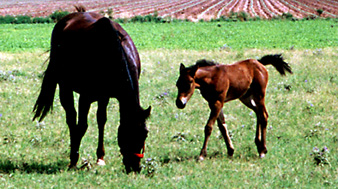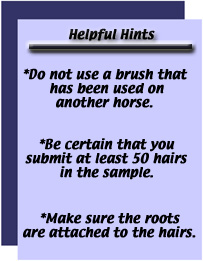|
DNA Test,
Percentage Verification... What does it mean for you? |
||||||
| by Kellye Fondy | ||||||
 Nearly
every time we turn on the television, log on to the Internet, or simply
listen to the evening newscast, we learn of new technology that is being
put to use to benefit us in some fashion. The equine industry is included
in this trend. Many times we do not associate things like DNA and blood
typing with our favorite sorrel or palomino pet in the barn. Well, listen
up because parentage verification is a hot topic in the horse world. Nearly
every time we turn on the television, log on to the Internet, or simply
listen to the evening newscast, we learn of new technology that is being
put to use to benefit us in some fashion. The equine industry is included
in this trend. Many times we do not associate things like DNA and blood
typing with our favorite sorrel or palomino pet in the barn. Well, listen
up because parentage verification is a hot topic in the horse world.Parentage verification is a term that refers to any scientifically tangible evidence that proves an animal or even a human traces to two specific parents. In other words, this verification process determines what horses can not be the parents of a certain foal. As a result, it serves as an insurance policy on the pedigree of a horse. As of 1995, all Quarter Horse stallions that breed at least four mares per year must have DNA genotypes on file at the American Quarter Horse Association. Mares born after Jan 1, 1995 must also be genotyped before any of her foals can be registered. The key change for horse owners is that instead of drawing blood and sending it to AQHA for a blood typing test, you are required to pull a small section of mane hair from just above the withers and attach the hairs to a kit. AQHA members can call or write the association for a DNA kit. It should arrive within a week upon request. The entire process includes a one-time charge of $50 and consists of two components. The first is a form that is returned to AQHA where it will remain on file to verify the DNA test. The second part of the test holds the hair samples, which are sent to the University of California at Davis, where all of the Association’s parentage verifications are sent. When you receive the requested kit , all of the information about the horse you are testing will simply be printed on the forms. It isimparative that you double check the information and make sure everything is correct. Mane hair is preferred because it is shorter and easier to handle than tail hair. The only exception to this is for foals younger than 60  days old. In this case, you will need to use tail hair. Mane hairs on foals
are too fine and can easily break or get damaged. It is very important to
include the roots of the hairs that you submit. An estimated 50 hairs are
needed for the test. The kit will come with detailed directions on how and
where to place the hair on the kit.
days old. In this case, you will need to use tail hair. Mane hairs on foals
are too fine and can easily break or get damaged. It is very important to
include the roots of the hairs that you submit. An estimated 50 hairs are
needed for the test. The kit will come with detailed directions on how and
where to place the hair on the kit.There are a few helpful hints that are very important to remember. You do not want to brush your horse’s mane with a brush that could possibly have another horse’s hair in it. The other horse’s hair could accidentally be included in the sample. Also, if you do trim the hair sample, be sure not to trim the wrong end, removing the roots from the hairs. Using DNA testing to verify parentage requires the hair samples of three parties: a sire, a dam, and a foal. The process answers this question: Could this specific mare and this specific stallion have made this foal? Through comparison of all three genotypes, DNA testing can eliminate stallions and mares that together could not have possibly created a particular foal. The probability of error is compared to finding a needle in a haystack!  Parentage
verification is not a new concept. Many equine registries have been practicing
this procedure for years. The new method is, however, using DNA instead
of blood typing for the verification. Blood samples cannot be used to determine
DNA results. Due to this problem, horse registries are facing internal stress
to convert to the new way of verification. If there are samples still on
file at the registry, the blood can be retested with DNA technology. This
of course takes much time and personnel to complete the task. Parentage
verification is not a new concept. Many equine registries have been practicing
this procedure for years. The new method is, however, using DNA instead
of blood typing for the verification. Blood samples cannot be used to determine
DNA results. Due to this problem, horse registries are facing internal stress
to convert to the new way of verification. If there are samples still on
file at the registry, the blood can be retested with DNA technology. This
of course takes much time and personnel to complete the task. This simple test can certify the pedigrees of the Quarter Horses we own, breed, buy, sell, ride, train and love. Anytime change comes about in an organization or a large industry such as this, there is some degree of hesitation. This procedure is easily completed and will be extremely beneficial to horse breeders and owners for years to come. |
||||||